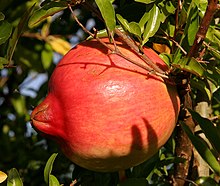Punica
Punica is a small genus of fruit-bearing deciduous shrubs or small trees. It belongs in the family Lythraceae.
| Punica | |
|---|---|

| |
| Punica granatum | |
| Scientific classification | |
| Kingdom: | Plantae |
| Clade: | Tracheophytes |
| Clade: | Angiosperms |
| Clade: | Eudicots |
| Clade: | Rosids |
| Order: | Myrtales |
| Family: | Lythraceae |
| Subfamily: | Punicoideae (Horan.) Graham, Thorne & Reveal |
| Genus: | Punica L. |
| Species | |
|
See text | |
| Synonyms | |
|
Socotria G.M.Levin[1] | |
Name
changeThe name of the genus Punica was given by Linnaeus in 1753 in Species Plantarum (Vol. 1, page 472). The type species is Punica granatum L.[2]
Punica comes from the Latin name for the pomegranate, malum punicum, meaning "Carthaginian apple" ("apple from Carthage").[3]
Description
changeThe species in this genus are shrubs or small trees that could grow up to 6 to 10 m (20 to 33 ft) high. Leaves are opossite. Flowers and fruits are yellow to bright red.
Fruits are berries with a strong skin, like leather. Fruits have many seeds with fleshy and edible coats (called sacrotesta).
Species
changeThere are only two species accepted in the genus Punica:[4]
- Punica granatum L., pomegranate. The pomegranate originated in the region of modern-day Iran, and has been cultivated since ancient times throughout the Mediterranean region and northern India.[3]
- Punica protopunica Balf.f., Socotra pomegranate. It is endemic to the island of Socotra. It differs from the common pomegranate because it has pink (not red) flowers and smaller, less sweet fruit.
Although previously placed in its own family Punicaceae, recent phylogenetic studies have shown that Punica belongs in the family Lythraceae, and it is classified in that family by the Angiosperm Phylogeny Group.
-
Plant of P. granatum with flowers
-
Flowers of P. granatum
-
Seeds of P. granatum
-
Flowers and young fruits of P. protopunica
References
change- ↑ "Genus: Punica L." Germplasm Resources Information Network. United States Department of Agriculture. 1998-06-02. Archived from the original on 2013-06-14. Retrieved 2012-12-09.
- ↑ Carolus Linnaeus. "Species Plantarum, Tomus I" (in Latin). p. 472. Retrieved 8 January 2017.
- ↑ 3.0 3.1 Morton, Julia F. (1987). "Pomegranate, Punica granatum L." Fruits of Warm Climates. Purdue New Crops Profile. pp. 352–355. Retrieved 8 January 2017.
- ↑ "Punica". The Plant List. Archived from the original on 5 September 2017. Retrieved 8 January 2017.